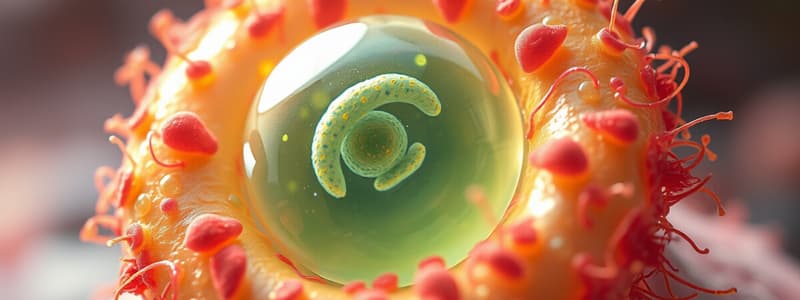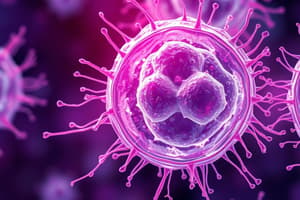Podcast
Questions and Answers
Which of the following components are found in all prokaryotic and eukaryotic cells?
Which of the following components are found in all prokaryotic and eukaryotic cells?
- Mitochondria
- Ribosomes (correct)
- Nucleus
- Golgi apparatus
What key feature distinguishes electron microscopy from light microscopy?
What key feature distinguishes electron microscopy from light microscopy?
- Ability to view large specimens
- Use of living specimens
- Use of glass lenses
- Higher resolution due to electron beams (correct)
Which of the following is NOT a component of the plasma membrane?
Which of the following is NOT a component of the plasma membrane?
- Proteins
- Phospholipids
- Nucleotides (correct)
- Cholesterol
In which solution will a plant cell experience turgor pressure?
In which solution will a plant cell experience turgor pressure?
Which of the following accurately describes facilitated diffusion?
Which of the following accurately describes facilitated diffusion?
Which of the following is a characteristic of eukaryotic cells?
Which of the following is a characteristic of eukaryotic cells?
What does it mean for a membrane to be selectively permeable?
What does it mean for a membrane to be selectively permeable?
Which of the following structures can be found in both plant and animal cells?
Which of the following structures can be found in both plant and animal cells?
Study Notes
Types of Microscopy
- Three main types: light microscopy, dissecting microscopy, electron microscopy.
- Light microscope uses visible light to magnify and resolve specimens, allowing details to be seen.
- Dissecting microscope provides lower magnification with a three-dimensional perspective, ideal for larger specimens.
- Electron microscopy uses beams of electrons instead of light, achieving much higher resolution and magnification than light methods.
Cell Theory
- Fundamental principles include: all living organisms are made of cells, cells are the basic unit of life, all cells arise from pre-existing cells.
Prokaryotic Cells
- Prokaryotic cells lack a membrane-bound nucleus and organelles; genetic material is found in a nucleoid region.
- Common components shared with eukaryotic cells: plasma membrane, ribosomes, and cytoplasm.
- Unique features of prokaryotes: smaller size, simpler structure, circular DNA (chromosomes), and lack of histones.
- Prokaryotic cells belong to the domains Bacteria and Archaea, distinguished by cell wall composition and metabolic pathways.
- Bacterial cells often have peptidoglycan in their cell walls, while archaeal cells lack this and have unique lipids.
- Reproduction occurs mainly through binary fission, a simple process of dividing into two identical cells.
Eukaryotic Cells
- Cytoplasm consists of cytosol, organelles, and various structures, excluding the nucleus.
- Flagella/Cilia: found on the cell surface for movement; flagella are longer and fewer, while cilia are shorter and numerous.
- Nucleus: houses genetic material; controls cellular activities.
- Ribosomes: site of protein synthesis; can be free-floating or attached to the endoplasmic reticulum.
- Rough Endoplasmic Reticulum (rER): studded with ribosomes; synthesizes and processes proteins.
- Smooth Endoplasmic Reticulum (sER): lacks ribosomes; synthesizes lipids and detoxifies substances.
- Golgi Apparatus: modifies, sorts, and packages proteins and lipids for transport.
- Vesicles/Vacuoles: transport materials within the cell; vacuoles store substances.
- Lysosomes: contain digestive enzymes; break down waste materials.
- Peroxisomes: involved in metabolism of fatty acids and detoxification.
- Mitochondria: powerhouse of the cell; produces ATP through cellular respiration.
Cytoskeleton
- Provides structural support and helps maintain cell shape; involved in intracellular transport and cell movement.
- Microfilaments: made of actin; involved in cell shape and motility.
- Intermediate filaments: provide mechanical support; stabilize cell structure.
- Microtubules: composed of tubulin; act as tracks for vesicle movement and form cilia/flagella.
Endomembrane System
- Comprises the nuclear envelope, endoplasmic reticulum, Golgi apparatus, lysosomes, vesicles, and the plasma membrane; facilitates transport and communication within the cell.
Comparison of Cells
- Plant vs. Animal Cells: Plant cells have a cell wall, chloroplasts, and large central vacuoles; animal cells do not.
- Structure varies, as plant cells typically appear rectangular while animal cells are round.
Cell Membrane
- All cells possess a plasma membrane, which regulates entry and exit of substances.
- Four components: phospholipids, proteins, carbohydrates, and cholesterol.
- Structure: bilayer of phospholipids with embedded proteins, cholesterol maintaining membrane fluidity.
- Functions: provides a barrier, facilitates communication, and regulates transport.
- Selectively permeable, allowing certain substances to pass while restricting others.
Passive Transport
- Mechanism where substances move across the membrane without energy, driven by concentration gradients.
- Diffusion: movement of molecules from high to low concentration; small, nonpolar molecules easily diffuse.
- Factors affecting diffusion: concentration gradient, temperature, size of molecules, and surface area.
- Facilitated Diffusion: process facilitating passage of larger or polar molecules through transport proteins.
- Osmosis: diffusion of water across a selectively permeable membrane; impacted by solute concentration.
- Osmotic Pressure: pressure needed to stop osmosis; Turgor Pressure specifically refers to pressure in plant cells due to fluid uptake.
- Solutions categorized as isotonic (equal solute concentration), hypotonic (lower solute concentration), and hypertonic (higher solute concentration).
- Water movement in solutions:
- In isotonic solutions, no net water movement.
- In hypotonic solutions, water enters cells, potentially causing them to burst.
- In hypertonic solutions, water exits cells, leading to shrinkage.
- Best environment for plant cells is hypotonic due to turgor pressure supporting cell structure.
Active Transport
- Requires energy to move substances against their concentration gradient.
- Electrochemical Gradient: difference in charge and concentration across a membrane affecting ion movement.
- Sodium-Potassium Pump: actively transports sodium out and potassium into cells; vital for maintaining membrane potential.
- Each cycle of the pump involves pumping three sodium ions out and two potassium ions in, crucial for nerve signal transmission and muscle contractions.
- Secondary Active Transport: utilizes the gradient established by primary transport to move other substances.
- Bulk Active Transport includes exocytosis (expelling substances) and endocytosis (taking in substances); types include phagocytosis, pinocytosis, and receptor-mediated endocytosis.
Studying That Suits You
Use AI to generate personalized quizzes and flashcards to suit your learning preferences.
Description
Explore the fascinating world of microscopy and cell theory in this quiz. You'll learn about different types of microscopes, the principles of cell theory, and key differences between prokaryotic and eukaryotic cells. Test your knowledge on the essential components of life and their classifications.




